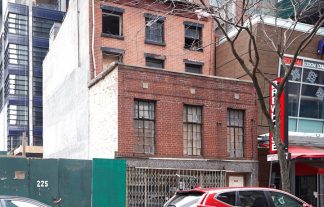Couretsy the City of New York
Abolitionist home in Downtown Brooklyn is granted landmark status
Prominent abolitionists lived at a three-story row-house on Duffield St., which could have been a stop on the Underground Railroad

227 Abolitionist Place
New York City has a new landmarked building, and it’s in Downtown Brooklyn.
From 1851 to 1863, abolitionists Harriet and Thomas Truesdell lived at a three-story row-house at 227 Duffield St., between Willoughby and Fulton streets—a location that may possibly have been a stop on the Underground Railroad.
The city’s 11-member Landmarks Preservation Commission voted unanimously Tuesday to grant the home landmark status, even though subsequent owners had altered the character of the facade by adding a storefront to the first two floors in 1933.
“Above this extension, the original 1850s facade, fenestration pattern, window surrounds and cornice remain, and the building’s form and historic fabric still convey its 19th century residential character and association with the Truesdells and Brooklyn’s significant abolitionist history,” the commission noted in its paperwork.
“This is an exciting day,” said commission chairperson Sarah Carroll at an online hearing Tuesday. “This property is significant for its long association with Harriet and Thomas Truesdell, who were noted abolitionists in Downtown Brooklyn and Brooklyn Heights and who also continued their work while living at this house.”
Downtown Brooklyn was a hub of abolitionist activity in the middle of the 19th century. Duffield Street itself was officially nicknamed “Abolitionist Place” in 2007. The Truesdell’s Greek revival-style home was constructed sometime between 1848 and 1851, according to the Landmarks Commission, which called it “a rare 19th century abolitionist’s home.”
Commission researchers could not irrefutably confirm that the house was in fact a stop on the Underground Railroad, as others in the neighborhood had been. But documentation has been scarce on those routes by design, and there are tunnels that connect the basement of the home to others nearby.
The home “represents one of the most important ties that New York has to our abolitionist roots,” New York Attorney General Letitia James said in a statement on Tuesday. “Roots that every Black New Yorker is proud of.”
The Truesdells were known abolitionists, associated with the American Anti-Slavery Society and the National Anti-Slavery Standard. They were active in the community and maintained a friendship with prominent fellow abolitionist William Lloyd Garrison.
Still, the road to landmark status was not smoothly paved: The building’s current owner Samiel Hasanab, filed for demolition in 2019, according to Brownstoner, with plans to erect a 13-story mixed use building, including an apartment complex, in its place. That development would have included a museum dedicated to Black history. But those plans sparked outrage, protests and the petition to register the property as a landmark, according to according to Brooklyner.
Those plans are now on ice.
“During this time of national reckoning over the legacy of slavery and continued injustice faced by Black communities, maintaining that piece of history is critical in remembering how far we’ve come,” the attorney general said. “And how far we still must go.”
You might also like 


























